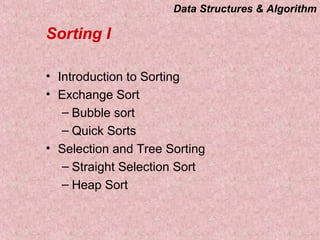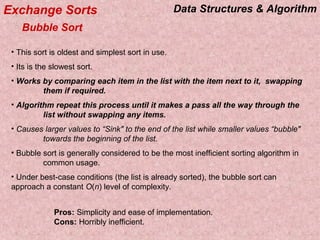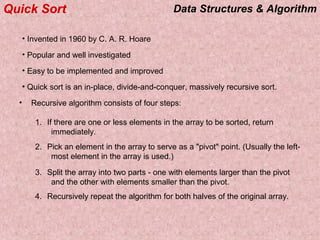Data Structures 6
- 1. Data Structures & Algorithm Sorting I Session VI Dr. V.Umadevi M.Sc(CS &IT). M.Tech (IT)., M.Phil., PhD., D.Litt., Director, Department of Computer Science, Jairams Arts and Science College, Karur.
- 2. Data Structures & Algorithm Sorting I • Introduction to Sorting • Exchange Sort – Bubble sort – Quick Sorts • Selection and Tree Sorting – Straight Selection Sort – Heap Sort
- 3. Data Structures & Algorithm Sorting General Def : Arrange the data in some appropriate order according to some key. Examples: • An English dictionary, in which all words are arranged in alphabetic order. • A phone directory, in which phone numbers are listed in some order. • Sorting is the fundamental algorithmic problem in computer science. • Learning the different sorting algorithms is like learning scales for a musician. • Formal Def : Given a sequence of numbers <x1, x2, ..., xn>, a sorting algorithm must compute a permutation <x'1, x'2, ..., x'n> such that x'1 ≤ x'2≤ ... ≤ x'n
- 4. Data Structures & AlgorithmExchange Sorts Bubble Sort • This sort is oldest and simplest sort in use. • Its is the slowest sort. • Works by comparing each item in the list with the item next to it, swapping them if required. • Algorithm repeat this process until it makes a pass all the way through the list without swapping any items. • Causes larger values to “Sink" to the end of the list while smaller values “bubble" towards the beginning of the list. • Bubble sort is generally considered to be the most inefficient sorting algorithm in common usage. • Under best-case conditions (the list is already sorted), the bubble sort can approach a constant O(n) level of complexity. Pros: Simplicity and ease of implementation. Cons: Horribly inefficient.
- 5. Data Structures & Algorithm void bubbleSort(int numbers[], int array_size) { int i, j, temp; for (i = (array_size - 1); i >= 0; i--) { for (j = 1; j <= i; j++) { if (numbers[j-1] > numbers[j]) { temp = numbers[j-1]; numbers[j-1] = numbers[j]; numbers[j] = temp; } } } } Source code for Bubble sort
- 6. Data Structures & AlgorithmExample: 1 2 3 4 5 6 7 // Positions ------------- 4 6 2 5 7 3 4 // Initial sequence 4 2 5 6 3 4 7 // Swapped: 2-3, 3-4, 5-6, 6-7; last_swap=6 2 4 5 3 4 6 7 // Swapped: 1-2, 4-5, 5-6; last_swap=5 2 4 3 4 5 6 7 // Swapped: 3-4, 4-5; last_swap=4 2 3 4 4 5 6 7 // Swapped: 2-3; last_swap=2 2 3 4 4 5 6 7 // No swapping; last_swap=0; end • Analysis: Best case performing one pass which require n-1 comparisons • Consequently best case is O(n). • Worst case performance of bubble sort is n(n-1)/ 2 comparison and exchange • Average case is analysis is O(n2 ). • Average number of comparison and exchanges are both O(n2 ). Bubble Sort Analysis
- 7. Data Structures & AlgorithmQuick Sort • Invented in 1960 by C. A. R. Hoare • Popular and well investigated • Easy to be implemented and improved • Quick sort is an in-place, divide-and-conquer, massively recursive sort. • Recursive algorithm consists of four steps: 1. If there are one or less elements in the array to be sorted, return immediately. 2. Pick an element in the array to serve as a "pivot" point. (Usually the left- most element in the array is used.) 3. Split the array into two parts - one with elements larger than the pivot and the other with elements smaller than the pivot. 4. Recursively repeat the algorithm for both halves of the original array.
- 8. Data Structures & Algorithm Initial Step - First Partition Sort Left Partition in the same way • Partition array into two segments. • First segment all elements are less than or equal to the pivot value. • Second segment all elements are greater or equal to the pivot value. • Sort the two segments recursively. • Pivot can only be found by scanning the whole array and this would slow down the algorithm. • Quick sort is fastest on average, but sometimes unbalanced partitions can lead to very slow sorting. • The best sorting algorithm when there is no infinite memory space.
- 9. Data Structures & Algorithm Quicksort Example Analysis • Worst-Case Analysis - the pivot is the smallest element, all the time (requires N recursive call of quicksort O(N)with comparison for a level). So the algorithm O(N2 )will be run in a time. • Best-Case Analysis - the pivot is in the middle, all the time. The running time is . O(N Log N) • Average-Case Analysis - each of the sizes for array (s1) is equally likely. The running time for this case is also O(N Log N) . Pros: Extremely fast. Cons: Very complex algorithm, massively recursive.
- 10. Data Structures & Algorithmvoid quickSort(int numbers[], int array_size) { q_sort(numbers, 0, array_size - 1); } void q_sort(int numbers[], int left, int right) { int pivot, l_hold, r_hold; l_hold = left; r_hold = right; pivot = numbers[left]; while (left < right) { while ((numbers[right] >= pivot) && (left < right)) right--; if (left != right) { numbers[left] = numbers[right]; left++; } while ((numbers[left] <= pivot) && (left < right)) left++; if (left != right) { numbers[right] = numbers[left]; right--; } } numbers[left] = pivot; pivot = left; left = l_hold; right = r_hold; if (left < pivot) q_sort(numbers, left, pivot-1); if (right > pivot) q_sort(numbers, pivot+1, right); } Code For Quick Sort
- 11. Data Structures & Algorithm Analysis of Exchange Sorts Exchange Sorts Running Time Algorithms Best Case Average Case Worst Case Bubble Sort O(n2 ) O(n2 ) O(n2 ) Quick Sort O(n Log n) O(n Log n) O(n2 )
- 12. Data Structures & AlgorithmStraight Selection Sort • Selection sort is one in which successive elements are selected in order and placed into their proper sorted positions. • Elements of the input may have to be preprocessed to make the ordered selection possible. • Def: An algorithm which orders items by repeatedly looking through remaining items to find the least one and moving it to a final location. • Select successive elements in ascending order and place them into their proper position. – Find the smallest element from the array, and exchange it with the first element. – Find the second smallest element, and exchange it with the second element. – Repeat until sorted in proper order. – Searching the smallest key in the record is called pass
- 13. Data Structures & Algorithm • 42 23 74 11 65 58 94 36 99 87 //Input • [11 ] 23 74 42 65 58 94 36 99 87 • [11 23 ] 74 42 65 58 94 36 99 87 • [11 23 36 ] 42 65 58 94 74 99 87 • [11 23 36 42 ] 65 58 94 74 99 87 • [11 23 36 42 58 ] 65 94 74 99 87 • [11 23 36 42 58 65 ] 94 74 99 87 • [11 23 36 42 58 65 74 ] 94 99 87 • [11 23 36 42 58 65 74 87 ] 99 94 • [11 23 36 42 58 65 74 87 94 ] 99 • 11 23 36 42 58 65 74 87 94 99 //Output • Selection sort works by selecting the smallest unsorted item remaining in the list, and then swapping it with the item in the next position to be filled. Example of Selection Sort
- 14. Data Structures & Algorithm •Starting near the top of the array extract the 3. •Then the above elements are shifted down until we find the correct place to insert the 3. •This process repeats in Figure(b) with the next number. • Finally, in Figure(c) complete the sort by inserting 2 in the correct place.
- 15. Data Structures & Algorithm • N-1 pass is required in order to perform the sort. • During the Ist pass in which the record with the smallest key is found n-1 records are compared. • In general for ith pass of the sort n-I comparisons are required. • Total number of comparisons is • Σn-1 n-I =n(n-1)/2 • i=1 • Therefore the number of comparison is proportional to n2 i.e O(n2 ) • Selection sort has a complexity of O(n2). Pros: Simple and easy to implement. Cons: Inefficient for large lists, so similar to the more efficient insertion sort that the insertion sort should be used in its place. Analysis of Selection Sort
- 16. Data Structures & Algorithm selection( int a[], int N) /* in C */ /* sort a[1..N], NB. 1 to N */ { int i, j, smallest, aSmallest, temp; for (i=1; i < N; i++) { /* invariant: a[1..i-1] sorted and elements a[1..i-1] <= a[i..N] */ smallest = i; /* find smallest in a[i..N] */ aSmallest = a[i]; for(j=i+1; j <= N; j++) /* a[smallest] is the least element in a[i..j-1] */ if ( a[j] < aSmallest ) { smallest=j; aSmallest=a[j]; } /* a[smallest] is the least element in a[i..j] */ temp=a[i]; a[i]=a[smallest]; a[smallest]=temp; /*swap*/ /* a[1..i] sorted and elements a[1..i] <= a[i+1..N] */ } /* a[1..N-1] sorted and elements a[1..N-1] <= a[N] */ /* i.e. a[1..N] sorted. */ Source Code for Selection Sort
- 17. Data Structures & Algorithm Heap Sort • Elegant and efficient, widely used. • No extra memory is needed. • Heap sort is based on a tree structure that reflects the packing order in a corporate hierarchy. • This method has two phases. • First the tree representing file is converted to heap • Second stage output sequence is generated in decreasing order • A heap is complete binary tree in which each node satisfies the heap condition represented as an array. Def- a heap is a list in which each entry contains a key and for all positions k in the list, the key at position k is at least as large as the keys in positions 2k and 2k+1 provided these positions exist in the list. • A complete binary tree is said to satisfy the heap condition if the key of each node is greater than or equal to the key in its children, thus the root node will have the largest key value.
- 18. Data Structures & Algorithm Analysis of Heap sort • Elegant and efficient, widely used. • No extra memory is needed. • On average, Heap sort is third place in speed. • But inner loop is a bit longer than that of Quick Sort, about twice as slow as Quick Sort on the average. • Building of the heap uses at most 2N comparisons, • In the worst case, at most 2n log n - O(n) comparisons are used by heapsort. • Good performance (NlogN) is guaranteed.
- 19. Data Structures & Algorithm Example of Heap Sort
- 20. Data Structures & Algorithm
- 21. Data Structures & Algorithm void heapSort(int numbers[], int array_size) { int i, temp; for (i = (array_size / 2)-1; i >= 0; i--) siftDown(numbers, i, array_size); for (i = array_size-1; i >= 1; i--) { temp = numbers[0]; numbers[0] = numbers[i]; numbers[i] = temp; siftDown(numbers, 0, i-1); } } void siftDown(int numbers[], int root, int bottom) { int done, maxChild, temp; done = 0; while ((root*2 <= bottom) && (!done)) { if (root*2 == bottom) maxChild = root * 2; else if (numbers[root * 2] > numbers[root * 2 + 1]) maxChild = root * 2; else maxChild = root * 2 + 1; if (numbers[root] < numbers[maxChild]) { temp = numbers[root]; numbers[root] = numbers[maxChild]; numbers[maxChild] = temp; root = maxChild; } else done = 1; } }




![Data Structures & Algorithm
void bubbleSort(int numbers[], int array_size)
{
int i, j, temp;
for (i = (array_size - 1); i >= 0; i--)
{
for (j = 1; j <= i; j++)
{
if (numbers[j-1] > numbers[j])
{
temp = numbers[j-1];
numbers[j-1] = numbers[j];
numbers[j] = temp;
}
}
}
}
Source code for Bubble sort](https://image.slidesharecdn.com/session6-180119051900/85/Data-Structures-6-5-320.jpg)




![Data Structures & Algorithmvoid quickSort(int numbers[], int array_size)
{ q_sort(numbers, 0, array_size - 1); }
void q_sort(int numbers[], int left, int right)
{
int pivot, l_hold, r_hold;
l_hold = left;
r_hold = right;
pivot = numbers[left];
while (left < right)
{
while ((numbers[right] >= pivot) && (left < right))
right--;
if (left != right)
{
numbers[left] = numbers[right];
left++;
}
while ((numbers[left] <= pivot) && (left < right))
left++;
if (left != right)
{
numbers[right] = numbers[left];
right--;
}
}
numbers[left] = pivot;
pivot = left;
left = l_hold;
right = r_hold;
if (left < pivot)
q_sort(numbers, left, pivot-1);
if (right > pivot)
q_sort(numbers, pivot+1, right);
}
Code For Quick Sort](https://image.slidesharecdn.com/session6-180119051900/85/Data-Structures-6-10-320.jpg)


![Data Structures & Algorithm
• 42 23 74 11 65 58 94 36 99 87 //Input
• [11 ] 23 74 42 65 58 94 36 99 87
• [11 23 ] 74 42 65 58 94 36 99 87
• [11 23 36 ] 42 65 58 94 74 99 87
• [11 23 36 42 ] 65 58 94 74 99 87
• [11 23 36 42 58 ] 65 94 74 99 87
• [11 23 36 42 58 65 ] 94 74 99 87
• [11 23 36 42 58 65 74 ] 94 99 87
• [11 23 36 42 58 65 74 87 ] 99 94
• [11 23 36 42 58 65 74 87 94 ] 99
• 11 23 36 42 58 65 74 87 94 99 //Output
• Selection sort works by selecting the smallest unsorted item remaining in
the list, and then swapping it with the item in the next position to be
filled.
Example of Selection Sort](https://image.slidesharecdn.com/session6-180119051900/85/Data-Structures-6-13-320.jpg)


![Data Structures & Algorithm
selection( int a[], int N) /* in C */ /* sort a[1..N], NB. 1 to N */
{ int i, j, smallest, aSmallest, temp;
for (i=1; i < N; i++)
{ /* invariant: a[1..i-1] sorted and elements a[1..i-1] <= a[i..N] */
smallest = i; /* find smallest in a[i..N] */
aSmallest = a[i];
for(j=i+1; j <= N; j++) /* a[smallest] is the least element in a[i..j-1] */
if ( a[j] < aSmallest )
{
smallest=j;
aSmallest=a[j];
} /* a[smallest] is the least element in a[i..j] */
temp=a[i];
a[i]=a[smallest];
a[smallest]=temp;
/*swap*/ /* a[1..i] sorted and elements a[1..i] <= a[i+1..N] */
} /* a[1..N-1] sorted and elements a[1..N-1] <= a[N] */
/* i.e. a[1..N] sorted. */
Source Code for Selection Sort](https://image.slidesharecdn.com/session6-180119051900/85/Data-Structures-6-16-320.jpg)




![Data Structures & Algorithm
void heapSort(int numbers[], int array_size)
{ int i, temp;
for (i = (array_size / 2)-1; i >= 0; i--)
siftDown(numbers, i, array_size);
for (i = array_size-1; i >= 1; i--)
{ temp = numbers[0]; numbers[0] = numbers[i]; numbers[i] = temp;
siftDown(numbers, 0, i-1);
}
}
void siftDown(int numbers[], int root, int bottom)
{ int done, maxChild, temp; done = 0;
while ((root*2 <= bottom) && (!done))
{ if (root*2 == bottom) maxChild = root * 2;
else if (numbers[root * 2] > numbers[root * 2 + 1])
maxChild = root * 2;
else maxChild = root * 2 + 1;
if (numbers[root] < numbers[maxChild])
{ temp = numbers[root];
numbers[root] = numbers[maxChild];
numbers[maxChild] = temp;
root = maxChild;
}
else done = 1;
}
}](https://image.slidesharecdn.com/session6-180119051900/85/Data-Structures-6-21-320.jpg)